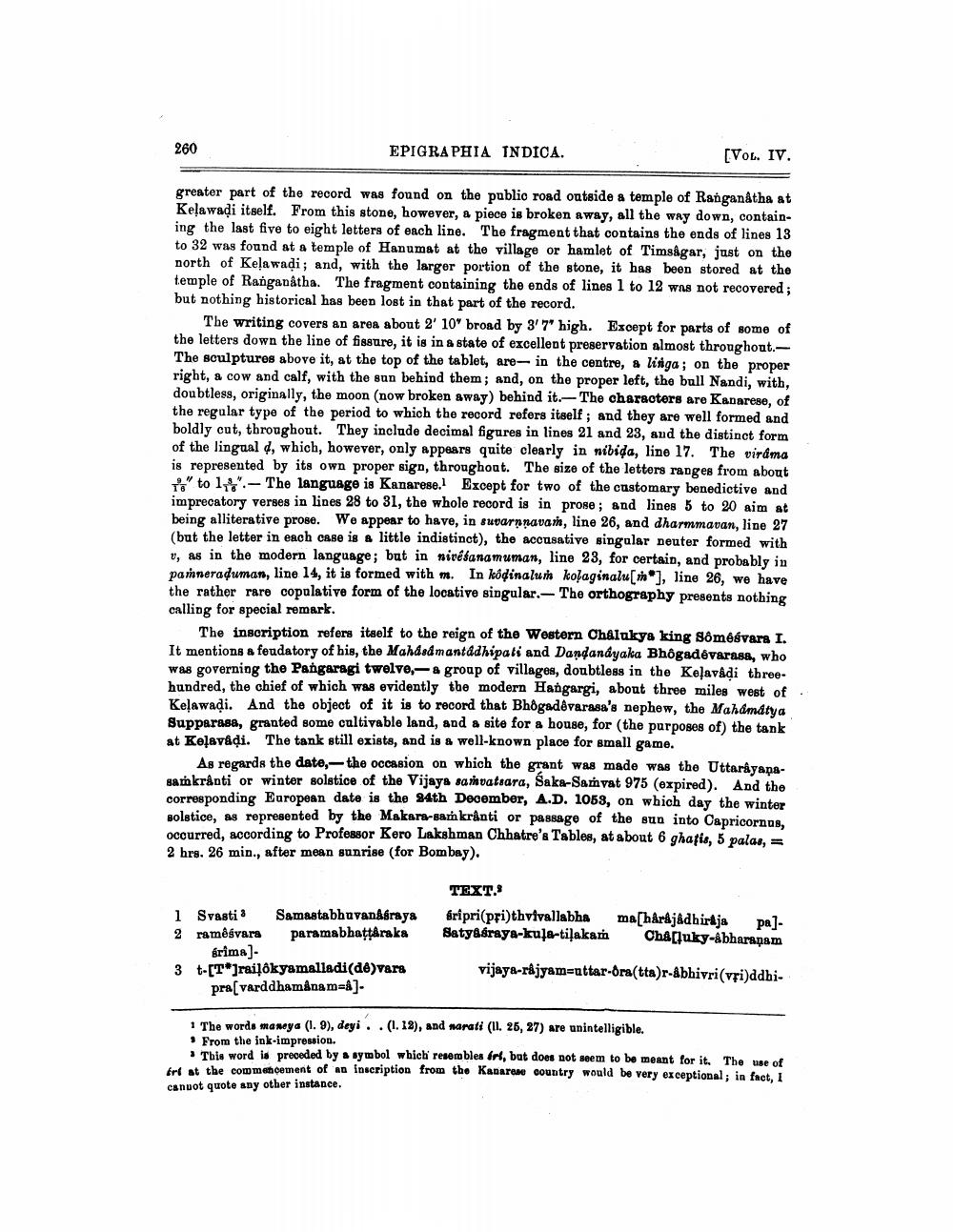________________
260
EPIGRAPHIA INDICA.
[VOL. IV.
greater part of the record was found on the public road outside a temple of Ranganatha at Kelawadi itself. From this stone, however, a piece is broken away, all the way down, containing the last five to eight letters of each line. The fragment that contains the ends of lines 13 to 32 was found at a temple of Hanumat at the village or hamlet of Timsågar, just on the north of Kelawadi; and, with the larger portion of the stone, it has been stored at the temple of Ranganatha. The fragment containing the ends of lines 1 to 12 was not recovered ; but nothing historical has been lost in that part of the record.
The writing covers an area about 2' 10broad by 3' 7high. Except for parts of some of the letters down the line of fissure, it is in a state of excellent preservation almost throughout.The sculptures above it, at the top of the tablet, are in the centre, & linga; on the proper right, a cow and calf, with the sun behind them; and, on the proper left, the bull Nandi, with, doubtless, originally, the moon (now broken away) behind it. The characters are Kanarese, of the regular type of the period to which the record refers itself; and they are well formed and boldly cut, throughout. They include decimal figures in lines 21 and 23, and the distinct form of the lingual d, which, however, only appears quite clearly in nibida, line 17. The virdma is represented by its own proper sign, throughout. The size of the letters ranges from about
"to 14" -The language is Kanarese. Except for two of the customary benedictive and imprecatory verses in lines 28 to 31, the whole record is in prose; and lines 5 to 20 aim at being alliterative prose. Wo appear to have, in suvarnnavam, line 26, and dharmmavan, line 27 (but the letter in each case is a little indistinct), the accusative singular neuter formed with v, as in the modern language; but in nivéfanamuman, line 23, for certain, and probably in panneraduman, line 14, it is formed with m. In kôdinaluri kolaginalu[m], line 26, we have the rather rare copulative form of the locative singular.- The orthography presents nothing calling for special remark.
The inscription refers itself to the reign of the Western Chalukya king Sômégvars I. It mentions a feudatory of his, the Mahdsdmantadhipali and Dandanayaka Bhôgadēvarasa, who was governing the Pangaragi twelve, a group of villages, doubtless in the Kelavadi threehundred, the chief of which was evidently the modern Hangargi, about three miles west of. Kelawadi. And the object of it is to record that Bhogadêvarasa's nephew, the Mahamatya Supparasa, granted some cultivable land, and a site for a house, for the purposes of the tank at Kolavadi. The tank still exists, and is a well-known place for small game.
As regards the date, the occasion on which the grant was made was the Uttarayanasankranti or winter solstice of the Vijaya saivatsara, Saka-Samvat 975 (expired). And the corresponding European date is the 94th December, A.D. 1053, on which day the winter solstice, as represented by the Makara Barkránti or passage of the sun into Capricornus. occurred, according to Professor Kero Lakshman Chhatre's Tables, at about 6 ghatis, 5 palas, = 2 hrs. 26 min., after mean sunrise (for Bombay).
TEXT. Sripri(pri)thvivallabha Satyasraya-kuja-tiļakam
mashárajadhirija pa]
Chaluky-ábharanam
1 Svasti 3 Samastabhuvan&frays 2 ramèsvara paramabhattáraka
grima). 3 t-[T]raiļôkyamalladi(de)vars
pra(varddhamanamaa)
vijaya-rajyam=uttar-Ora(tta)r-abhivri(vpi)ddhi
1 The words mamya (1. 9), deyi.. (1.1%), and narati (II. 26, 27) are unintelligible. • From the ink-impression.
This word is preceded by a symbol which resembles irl, but does not seem to be meant for it. The use of tri at the commencement of an inscription from the Kanaree country would be very exceptional; in fact, I canuot quote any other instance.




